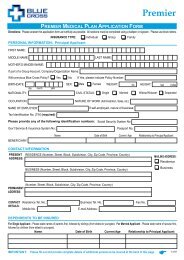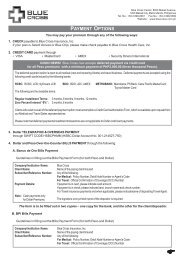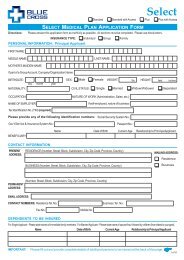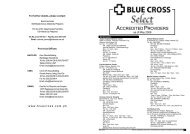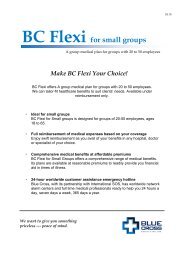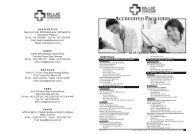Health Book_03-Special Features_2011_web.pdf - Blue Cross
Health Book_03-Special Features_2011_web.pdf - Blue Cross
Health Book_03-Special Features_2011_web.pdf - Blue Cross
Create successful ePaper yourself
Turn your PDF publications into a flip-book with our unique Google optimized e-Paper software.
<strong>Blue</strong> <strong>Cross</strong> <strong>Health</strong> BOOKXIIunderstanding a new influenza strain2009 H1N1 FLU AND YOUDetails below are from the Centers for Disease Control and Prevention (Atlanta, U.S.A.).Information is as of August 2009.What is 2009 H1N1?The 2009 H1N1 (referred to as, “swine flu” early on) is a new influenza virus causing illness in people.This new virus was first detected in the United States in April 2009. This virus is spreading from personto-personworldwide, probably in much the same way that regular seasonal influenza viruses spread.On 11 June 2009, the World <strong>Health</strong> Organization (WHO) signaled that a pandemic of 2009 H1N1 fluwas underway.Why is 2009 H1N1 virus sometimes called “swine flu”?This virus was originally referred to as “swine flu” because laboratory testing showed that many of thegenes in this new virus were very similar to influenza viruses that normally occur in pigs (swine) in NorthAmerica. However, further study has shown that this new virus is very different from what normallycirculates in North American pigs. It has two genes from flu viruses that normally circulate in pigs in Europeand Asia and bird (avian) genes and human genes. Scientists call this a, “quadruple reassortant” virus.Is 2009 H1N1 virus contagious?CDC has determined that 2009 H1N1 virus is contagious and is spreading from human to human.How does 2009 H1N1 virus spread?Spread of 2009 H1N1 virus is thought to occur in the same way that seasonal flu spreads. Flu virusesare spread mainly from person to person through coughing or sneezing by people with influenza.Sometimes people may become infected by touching something such as a surface or object with fluviruses on it and then touching their mouth or nose.What are the signs and symptoms of this virus in people?The symptoms of 2009 H1N1 flu virus in people include fever, cough, sore throat, runny or stuffy nose,body aches, headaches, chills and fatigue. A significant number of people who have been infected withthis virus have also reported diarrhea and vomiting. Severe illnesses and death have occurred as aresult of illness associated with this virus.How severe is illness associated with 2009 H1N1 flu virus?Illness with the 2009 H1N1 virus has ranged from mild to severe. While most people who have beensick have recovered without needing medical treatment, hospitalizations from infection with this virushave occurred.Who are at “high risk” with the 2009 H1N1 flu virus?In seasonal flu, certain people are at “high risk” of serious complications. This includes people 65 yearsand older, children younger than five years old, pregnant women, and people of any age with certainchronic medical conditions. About 70% of people who have been hospitalized with the 2009 H1N1virus have had one or more medical conditions previously recognized as placing people at “high risk” ofserious seasonal flu-related complications. This includes pregnancy, diabetes, heart disease, asthmaand kidney disease.One thing that appears to be different from seasonal influenza is that adults older than 64 years old do notyet appear to be at increased risk of 2009 H1N1-related complications thus far. CDC laboratory studies2009 H1N1 FLU AND YOU



